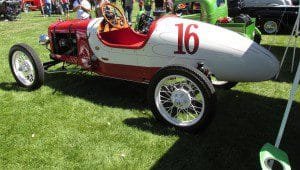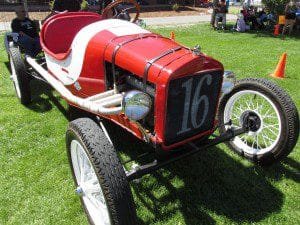The historic Ford Model T was a car for the masses. It was an automobile built to be affordable with Henry Ford making a little profit on every car sold. This formula of course worked very well with Ford’s assembly line being able to produce more cars in much shorter times. The key for Henry Ford was to sell a lot of automobiles.
The Ford Model T Racer featured in this article is a great representation of what these cars looked like when they ran on dirt tracks as well as the Indy 500.

Not many people equate speed with the Model T and speed wasn’t one of it’s attributes. The Ford Model T we are accustomed to seeing was built to be a rugged automobile that could navigate the primitive roadways of the early 1900’s. What’s very interesting is how the Model T also found a place in early automobile racing.
The Model T Racers
Competition was important to familiarize the public with the new horseless carriage. The first official road race is thought to have been the 54 mile run in Chicago in 1895 won by Frank Duryea in a race that lasted about 10 1/2 hours. Duryea’s average speed was calculated to have been 5 1/4 MPH.
You may also enjoy our articles on the links below…
The 1971 Indy Johnny Lightning Special

The Model T Racers
After World War One was over the American public fell in love with the automobile. The Ford Model T was a relatively inexpensive car of the times that could supply a solid chassis for mechanics to experiment with. Here was the foundation that enterprising mechanics could enhance with performance innovations. By 1920 there were about 6 million Ford Model T’s built. When Model T production ended in the 1920’s some 15 million of the vehicles were built. This sturdy car was a natural for the aftermarket performance industry.
The Fronty-Ford Racer
The Ford Model T’s factory 22 horsepower engine was ready to be cranked up quite a bit. A company known by the brand name Frontenac and developed by the three Frontenac brothers began doing Model T conversions in the very early 1920’s. The company was owned by Louis and Arthur Chevrolet and located in Indianapolis Indiana. The Chevrolet’s worked with the Frontenac brothers in this joint venture. The work of this company was to develope racing heads for Model T’s. Yes, the Chevrolet brothers were in the business of making parts for Ford automobiles. Their first Frontenac Model T racing conversions competed on dirt tracks but that would soon change. One of the Frontenac Model T conversions came in at fifth place during the 1923 Indianapolis 500.

What powered this 1923 Fronty-Ford to place so well in the Indy 500 was it’s Frontenac Cylinder Head that allowed the racer to average about 83 MPH. The Frontenac configured engine was advertised as being able to go from 5 to 40 MPH in 16 seconds.
The Frontenac Cylinder Heads were offered in three versions. There was the “T” that was geared for touring cars and trucks. There was the “S” which was for speedsters and the “R” which was a racing head. The Frontenac race car conversions allowed for tripling of the normal Model T horsepower. These overhead valve conversion kits were among the most popular of the 1920’s.

The Barber-Warnock Ford
The 1923 Indy car that finished in fifth place was driven by L.L. Corum. It was a Barber-Warnock Ford with the Fronty-Ford 122 cubic inch Inline 6 engine on a Model T chassis. During that event engine displacements were reduced from 183 to 122 cubic inches. Barber Warner was an automobile dealer in Indiana. One special photo that was taken shows Henry Ford in the seat of a Barber Warnock Ford Racer at the Indianapolis 500 Race Track in May 1924. Barber Warnock entered conversion Ford Model T’s in both the 1923 and 1924 Indy 500.
(Article and photos copyright 2014 AutoMuseumOnline)